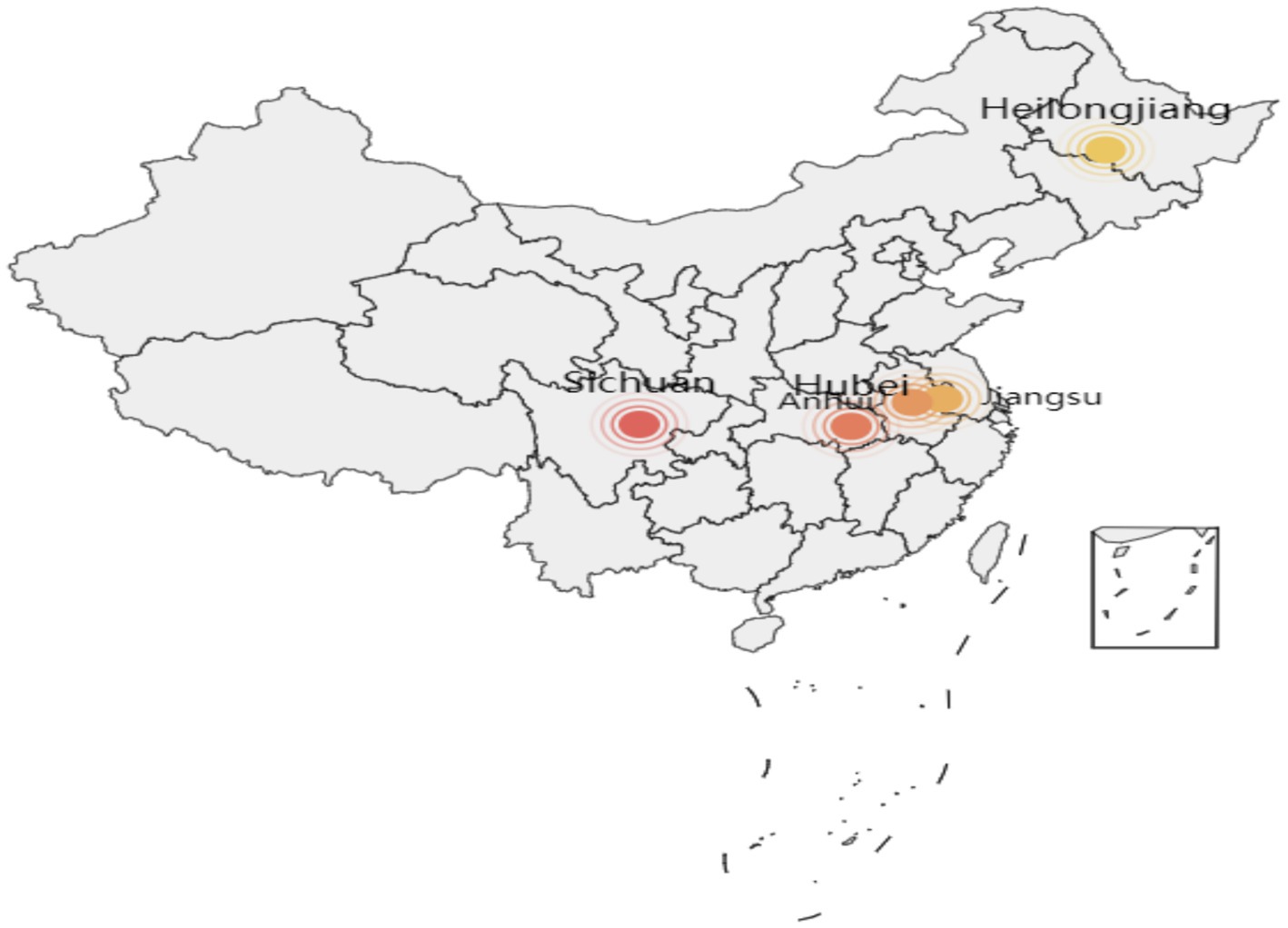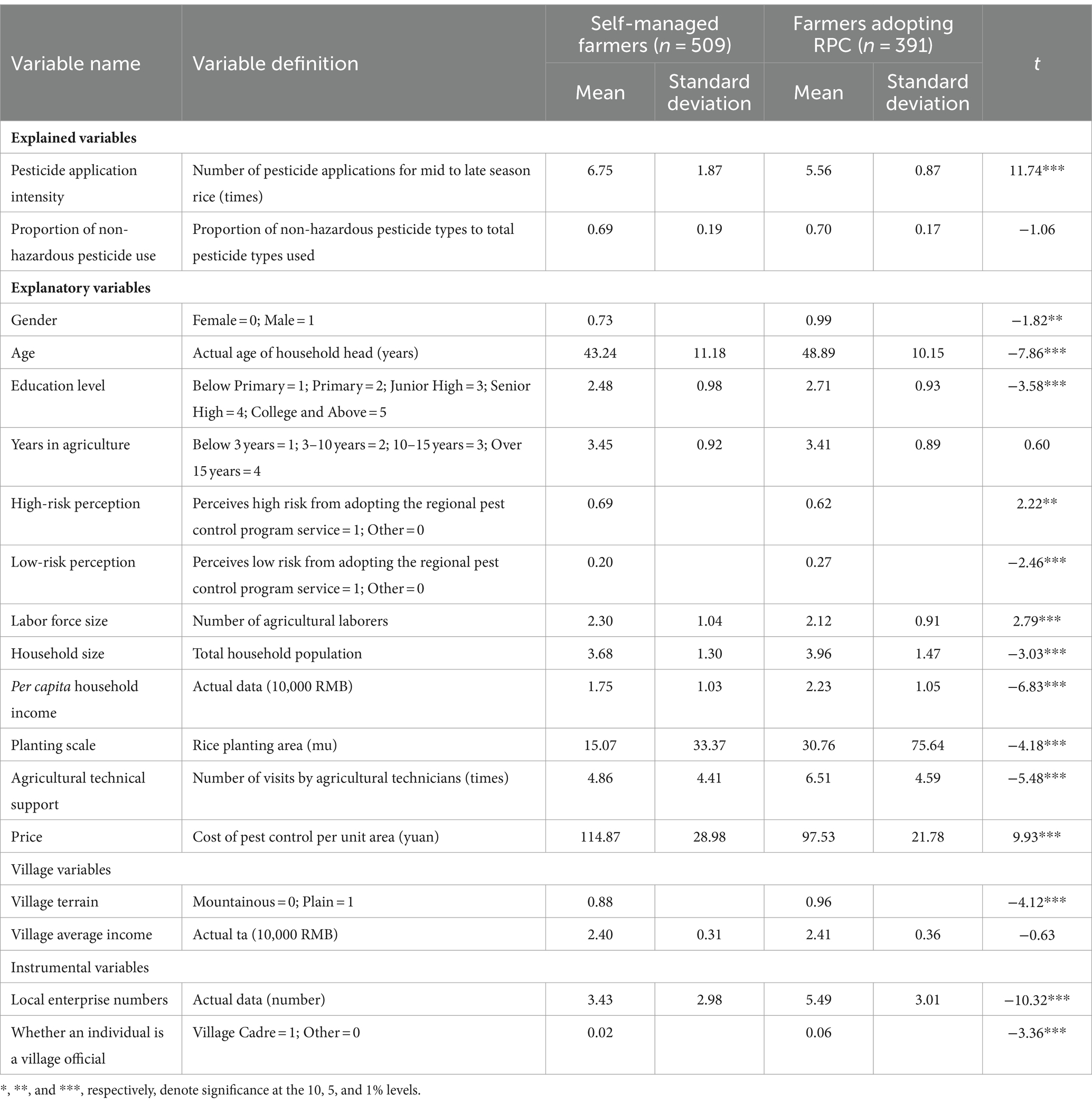- 1Business School, Linyi University, Linyi, China
- 2School of Economics and Management, Suqian University, Suqian, China
The Regional Pest Control program represents a strategic intervention aimed at optimizing pesticide use in crop production, thereby mitigating the environmental impact of agricultural non-point source pollution from pesticides and fostering the development of high-quality agriculture. This study examines the influence of farmers’ perceived risks on the adoption of the Regional Pest Control program and evaluates its effect on pesticide application across a nationally representative dataset from Heilongjiang, Jiangsu, Anhui, Hubei, and Sichuan provinces. To account for unobserved heterogeneity, an endogenous switching regression model was employed. The findings reveal that farmers’ perceived risks associated with the Regional Pest Control program significantly deter its adoption. Furthermore, the program has been effective not only in reducing the frequency of pesticide applications but also in increasing the usage of pesticides with lower acute toxicity levels. Notably, the impact of the Regional Pest Control program on pesticide application demonstrates considerable variation in accordance with farmers’ risk attitudes.
1 Introduction
Over the past four decades, China’s economy has experienced rapid growth, leading to significant advancements in agriculture and a substantial increase in agricultural production. However, the management of pests and crop diseases has predominantly relied on pesticides, leading to an escalation in their excessive use (Xingdong and Xuexi, 2019; Narayanan et al., 2024). Between 1990 and 2016, China’s pesticide application surged from 0.733 million tons to 1.74 million tons, marking an increase of 1.007 million tons and an average annual growth rate of 3.87%. Concurrently, the average annual growth rate of pesticide application per hectare of farmland in China was 2.11%, in contrast to the downward trend observed during the same period in developed countries such as Britain, France, and Japan. Furthermore, even in Vietnam, a developing country, the amount of pesticide applied per hectare decreased by 24% (Ngo-Hoang, 2024). Notably, the intensity of pesticide application per hectare in China is significantly higher, being only 40% of the global average (Ke, 2017). The excessive use of pesticides on cultivated land and in water bodies has severely affected the environment and consumer health, posing challenges to the export of agricultural products from China (Ren et al., 2023; Xu et al., 2023).
The academic community discusses the increasing focus on factors influencing pesticide use, especially the mechanisms behind farmers’ application decisions. It presents two perspectives: one posits that farmers, assuming a risk-averse stance, may over-apply pesticides to mitigate yield loss risks from pests and diseases (Skinner et al., 2016; Hou et al., 2020). Another perspective addresses the trust factor in agricultural product consumption and the issue of information asymmetry, leading to excessive pesticide use due to the dispersed smallholder farming structure in China and high regulatory costs (Fabregas et al., 2019; Zhao et al., 2020). It also considers farmers’ individual characteristics, agricultural training, off-farm work, and cooperative membership (Belay et al., 2017; Ning et al., 2024; Peng et al., 2024). Additionally, the role of biotechnologies, such as genetically modified organisms (GMOs), in reducing pesticide usage and mitigating agricultural non-point source pollution is highlighted, emphasizing the potential for GMOs to enhance food quality and safety (Huang et al., 2008; Gbashi et al., 2021).
Existing research has contributed to our understanding of the micro-mechanisms driving farmers’ pesticide applications, aiding in efforts to reduce pesticide use and mitigate agricultural non-point source pollution. However, several areas within the current body of research on this topic in China warrant further exploration. Firstly, there is a lack of compelling evidence to demonstrate significant differences in risk preferences among farmers globally. Therefore, the utility of risk preference as an explanation for the higher pesticide application rate per hectare of farmland in China compared to other countries remains questionable. Secondly, while the academic community has suggested interventions such as enhanced government regulation, agronomic training, and the issuance of deterrent signals to counteract farmer opportunism in pesticide application (Kang et al., 2015), the prevailing industrial organization model of smallholder farming in China inherently limits the effectiveness of these policy measures. Lastly, although biotechnological advances, such as genetic modification, have been shown to reduce pesticide usage, their adoption and application face constraints, particularly in the realm of consumable agricultural products, due to ongoing safety debates in China. A robust agricultural ecological environment is essential not only for achieving the objectives of rural revitalization and agricultural supply-side structural reform but also for fostering high-quality agricultural development in China. Both government and academic sectors are giving increasing attention to the challenge of addressing agricultural non-point source pollution through agricultural social services. This focus aligns with the broader push for agricultural supply-side structural reform and the implementation of the rural revitalization strategy, embedding China’s agricultural production more deeply within the framework of the agricultural socialized service system. The evolution of this system is a critical element of the agricultural supply-side structural reform initiative.
To address the issue of excessive pesticide use in China’s agriculture, enhance the agricultural ecological environment, and promote high-quality agricultural development, the Ministry of Agriculture initiated the Regional Pest Control program in 2008. This program involves socialized crop pest control services where organizations provide paid pest control services to farmers. By employing the unified mode of epidemic situation prediction, control time, control pesticide and spraying construction, these services aim to reduce pesticide use while ensuring agricultural output (Chaoan, 2011). By the end of 2016, the Regional Pest Control program’s socialized services had extended to 35.5% of the country’s crop area (Fan and Yunyun, 2023). Nevertheless, a scientific evaluation is required to ascertain whether the program has succeeded in decreasing pesticide use and increasing the use of low-toxicity, efficient pesticides. Internationally, scholars have thoroughly examined the role of different service organizations within the agricultural socialization service system and its effects on organic agriculture and sustainable agricultural growth (Carney, 1995; Labarthe and Laurent, 2013; Pedersen et al., 2019; Wuepper et al., 2021). Conversely, Chinese research on the link between agricultural socialized services and pesticide application, particularly the impact of the Regional Pest Control program on agricultural non-point source pollution from excessive pesticide use, is less developed. Only Ying Ruiyao and Bin (2017) utilized the Propensity Score Matching (PSM) method to explore the Regional Pest Control program’s effect on pesticide application intensity (Ruiyao and Bin, 2017). However, the econometric models used in existing studies have not fully addressed the endogeneity issue arising from self-selection, thus failing to accurately capture the program’s real impact on pesticide application. Moreover, while the PSM method can correct for self-selection errors due to observable farmer heterogeneity, it cannot account for unobservable heterogeneity (e.g., farmers’ skills, risk preferences), leading to potential “hidden bias”(Ma and Abdulai, 2016), which may skew the analysis results. Furthermore, pest control represents a high-risk aspect of agricultural production. Previous research has inadequately considered how farmers’ risk perception of the Regional Pest Control program influences their adoption behavior and the differential impact of the program on pesticide application among farmer groups with varying risk preferences.
This study applies the Endogenous Switching Regression (ESR) model to address sample selection bias resulting from both observable and unobservable farmer heterogeneity (Lokshin and Sajaia, 2004), analyzing the Regional Pest Control program’s effect on pesticide use in China. It significantly enhances the understanding of the role of farmers’ risk perception in adoption behavior, addresses endogenous issues arising from self-selection in decision-making, and evaluates the program’s impact across different groups of farmers’ risk preference. This multifaceted approach offers deeper insights into behavioral drivers and program effectiveness, contributing to more nuanced policy development in agricultural pest management.
2 Theoretical framework
Farmers, when deciding to adopt the Regional Pest Control program, face multiple constraints related to resources, information, and technology accessibility, and exhibit heterogeneity in their responses. If the Regional Pest Control program only result in reduced pesticide use without offering benefits that compensate for their costs, farmers are unlikely to adopt such services. Thus, farmers’ adoption decisions can be analyzed from a constraint optimization perspective: they will adopt the Regional Pest Control program only if the perceived benefits exceed the costs.
indicates the utility of farmers’ adoption of Regional Pest Control program, while represents the utility of farmers not adopting Regional Pest Control program. indicates the expected utility of farmers adopting Regional Pest Control program. Under the framework of random utility analysis, only when the expected net utility of Regional Pest Control program adopted by farmers is positive, that is , or , rational farmers will choose to adopt it. Given that the net utility derived from adopting the Regional Pest Control program is intangible and hence unobservable, it can be conceptualized as a latent variable. This latent variable encompasses the individual characteristics of farmers, including observable attributes such as educational attainment, their perceptions of the risks associated with adopting the Regional Pest Control program, and other unobservable factors. These are integrated with a function of independent and identically distributed error terms to model the decision-making process accurately.
Compared to individual pest control efforts by small-scale farmers, the Regional Pest Control program significantly mitigates the inefficiencies inherent in such decentralized approaches, including the inadequate capacity to manage large-scale disease and pest outbreaks, the non-specific application of pesticides, and the tendency toward excessive pesticide use. The advantages of the Regional Pest Control program in pesticide application management manifest in several key areas: First, Resource Advantage for Prevention and Control. The limited access of farmers to technical information crucial for agricultural production substantially influences pesticide application rates (Abdul Salam and Phimister, 2017). Pest control is a complex activity requiring high levels of technical knowledge and skill for the scientific application of pesticides. The ongoing labor migration from agriculture has led to an aging agricultural workforce, complicating the acquisition of pest control techniques and skills. This situation often results in excessive pesticide residues and overuse (Win et al., 2020; Zhang et al., 2023). In contrast, agricultural technology departments can provide targeted technical support and training to a select number of Regional Pest Control program organizations, Furthermore, the adoption of large-scale and efficient plant protection machinery by these organizations can address the inefficiencies and coverage issues associated with manual spraying by individual farmers. Second, Timeliness of Plant Protection. Climate warming has accelerated the spread of many diseases and pests, necessitating rapid and large-scale response measures. The Regional Pest Control program, with its unified approach to epidemic forecasting, control timing, agent selection, and organizational prevention, can effectively respond within the critical window for disease and pest control, swiftly mitigating outbreaks (Fuchu, 2017). Third, Reduced Monitoring Costs for Prohibited Pesticides: The diverse pest control strategies, pesticide selections, and procurement channels utilized by individual farmers lead to high supervision costs and inefficiencies. The Regional Pest Control program simplifies government oversight by centralizing pesticide procurement, thereby facilitating the regulation of pesticide use and encouraging the shift toward more efficient and less toxic pesticide applications (Chaoan, 2011).
To address the issue of sample selection bias and ensure the consistency of estimated results, this study employs a simultaneous equation model, specifically the endogenous switching regression (ESR) method. This approach analyzes the impact of farmers’ adoption of the Regional Pest Control program on pesticide application by considering the decision-making process for pest control and pesticide application as endogenous variables.
3 The research method
The Endogenous Switching Regression (ESR) model encompasses two primary stages: Firstly, a selection equation is formulated, whereby farmers assess the feasibility of adopting the Regional Pest Control program based on their individual resources and operational circumstances. Subsequently, the model delineates two outcome equations aimed at elucidating the variables of interest, specifically pesticide application. These equations articulate the relationship between the vector of explanatory variables and the outcome variable. The ESR model concurrently estimates the following three equations:
Selection equation (Whether farmers adopt the Regional Pest Control program)
In the proposed model, represents a binary variable indicating the adoption of the Regional Pest Control program by farmers, where if the program is adopted and otherwise. The vector consists of parameters estimated in Equation 1, while encompasses variables such as the characteristics of the farmer, agricultural production and operational status, and household attributes. The error term, , is presumed to follow a normal distribution. The parameters and , to be estimated in Equations 2, 3 respectively, quantify the impact of adopting the Regional Pest Control program on pesticide application. A distinction between in Equation 1 and in Equations 2, 3 involves the inclusion of instrumental variables in to facilitate model identification. These instrumental variables are selected on the basis that they influence the decision to adopt the Regional Pest Control program but are unassociated with the level of pesticide application. For instance, the presence of local enterprises can increase non-farm employment opportunities for farmers, yet it bears no direct relation to pesticide usage levels. Similarly, the status of being a village cadre might encourage the adoption of government-promoted Regional Pest Control programs, but this status does not directly affect pesticide application rates. Consequently, this study identifies “the number of local enterprises” and “village cadre status” as instrumental variables for inclusion in the model concerning the adoption of the Regional Pest Control program.
The Endogenous Switching Regression (ESR) model employs a counterfactual framework to analyze expected outcomes under alternative scenarios. It posits hypothetical situations where farmers who have adopted the Regional Pest Control program did not do so, and conversely, those who have not adopted the program did. This study applies the ESR model to assess expected variations in pesticide application across these counterfactual scenarios. The conditional expected outcomes for each scenario are delineated as follows:
Observable pesticide application by farmers who have adopted Regional Pest Control program.
Counterfactual pesticide application by farmers who have adopted the Regional Pest Control program.
Observed pesticide application by farmers who did not adopt the Regional Pest Control program.
Counterfactual pesticide application by farmers who have not adopted the Regional Pest Control program.
In Equation 4e, and also are known as the inverse Mills ratios, where represents the standard normal probability density function, and denotes the standard normal cumulative distribution function. The ESR (Endogenous Switching Regression) model estimates not only the marginal impacts of explanatory variables on the outcome variable (pesticide use) but also calculates the treatment effects of farmers adopting socialized pest and disease control services on pesticide use. According to Heckman et al. (2001) and Greene (2012), Equations 4a–4d are used to compute the net impact of the adoption of socialized services on pesticide use, denoting the average treatment effect on the treated (ATT) and the average treatment effect on the untreated (ATU). The values for ATT and ATU are derived from Equations 5, 6 respectively.
The results from the Dubin-Wu–Hausman endogeneity test (hereafter referred to as the DWH test) decisively reject the null hypothesis that the decision by farmers to adopt the Regional Pest Control program functions as an exogenous variable at a significance level of 1%. This finding indicates that treating the adoption of the Regional Pest Control program as an exogenous variable in Equations 2, 3 introduces endogeneity, potentially leading to inconsistent estimation outcomes if one were to apply an Ordinary Least Squares (OLS) model. A critical prerequisite for the effective utilization of the Endogenous Switching Regression (ESR) model is the fulfillment of the exclusivity constraint test. This test ensures proper model identification by requiring that there be at least one instrumental variable influencing the decision to adopt the Regional Pest Control program that does not directly affect pesticide application. This necessitates that the instrumental variable(s) have a direct impact on the adoption decision without directly influencing pesticide application levels. To validate the efficacy of “number of local enterprises” and “village cadre status” as instrumental variables, it is essential to demonstrate that these variables, along with others, satisfy the exclusivity constraint. This involves showing that these variables influence the decision to adopt the Regional Pest Control program but have no direct effect on pesticide application levels. The validity of using “number of local enterprises” and “village cadre status” as instrumental variables was assessed through Probit and OLS regressions on the adoption decision and pesticide application equations, respectively, incorporating these and other variables to ensure a robust analysis. The results indicated that “the number of local enterprises” and “whether the farmer is a village cadre” did not significantly affect the method of pesticide application but had a significant influence at the 1% level on “whether farmers adopt agricultural socialized services.” The rank LM χ2 statistic of the K-P test rejected the null hypothesis at the 1% significance level, signifying the model’s identifiability. Additionally, the Cragg-Donald Wald F statistic’s rejection of the null hypothesis at the 1% level suggests no weak instrument issue, affirming the effectiveness of the chosen instrumental variables.
4 Sample, data and variables
4.1 Sample and data sources
4.1.1 Sample selection
The genesis of agricultural non-point source pollution in China is multifaceted, with the overuse and misuse of pesticides in crop cultivation identified as a pivotal factor. Consequently, this study has chosen the Regional Pest Control program, which is intrinsically linked to pesticide application during crop production, as the sample for investigation. This selection aims to elucidate the program’s impact on pesticide usage in rice cultivation, offering insights into potential mitigative measures for pollution.
4.1.2 Data sources
The data collection for this study was conducted between July and September 2017. To ensure the representativeness of the survey sample and to mitigate the confounding effects of varying economic development levels and regional disparities on the evolution of agricultural social services, a stratified sampling method was employed. The research team selected five provinces: Heilongjiang, Jiangsu, Anhui, Hubei, and Sichuan, which is shown in Figure 1. These provinces, situated in the eastern, central, and western regions of China, were chosen based on their substantial rice production and the representativeness of their local rice cultivation statuses. Collectively, these provinces contributed to approximately 60% of China’s total rice output in 2017. They are characterized by an extensive history of rice cultivation, large cultivation areas, and a relatively advanced state of Regional Pest Control implementation. Within each province, two counties were chosen, and from each county, two Regional Pest Control program service entities were randomly selected with assistance from the local agricultural departments. Correspondingly, two villages within the service jurisdiction of each pest control entity were selected as sampling points. Subsequently, 20 to 25 rice farmers were randomly chosen from each village using a stratified random sampling approach. From this survey, 948 questionnaires were collected, with 900 deemed valid, resulting in an effective response rate of 94.93%. The questionnaires encompassed four domains: individual farmer characteristics, household demographics, fundamental agricultural operations, and village attributes.
4.2 Variable selection
4.2.1 Explained variable
Scientifically measuring the application of pesticides in rice production is complex. For the purposes of this study, “Pesticide Application Intensity” and “Proportion of Non-hazardous Pesticide Usage” are employed as quantitative and qualitative indicators of scientific pesticide application levels in rice production. “Pesticide Application Intensity” is quantified by the number of pesticide applications during a single mid to late rice-growing season, while “Proportion of Non-hazardous Pesticide Usage” is measured by the proportion of non-hazardous pesticides used out of the total pesticides applied. Although this approach is not flawless, it offers a valuable framework for analysis.
4.2.2 Key explanatory variables
The key explanatory variables in this paper focus on farmers’ subjective perception of the potential yield loss risk from adopting the Regional Pest Control program, its influence on their adoption behavior, and the subsequent impact on pesticide application in rice production. Farmers’ risk perception of adopting these services is based on their subjective evaluation and categorized into three levels: low, medium, and high. Measurement of farmers’ risk preference utilizes the payoff matrix method, classified as risk-averse, risk-neutral, or risk seeking. The choice to adopt the Regional Pest Control program is self-selected by farmers, which necessitates addressing endogeneity issues arising from such self-selection in key explanatory variables.
4.2.3 Other explanatory variables
To analyze the impact of farmers’ adoption of the Regional Pest Control program on pesticide use in rice production, this study incorporates 13 variables across four categories based on existing research and the specific context of rice production in China. These include characteristics of farmers such as age, gender, and education level; family features like the number of agricultural laborers, total household population, and per capita household income; operational variables such as the scale of rice planting, the cost of the Regional Pest Control program, and the intensity of agricultural technical support; and village attributes including terrain and average village income. Descriptive statistics for these main variables are presented in Table 1.
5 Empirical results analysis
5.1 Factors influencing farmers’ adoption of the regional pest control program service and the intensity of pesticide usage
In the ESR model estimates presented in Table 2, the LR test of independence of equations rejects the null hypothesis of independence between the selection equation and the outcome equation at the 1% significance level. The coefficients are significantly different from zero at the 1% level, indicating that the choice to adopt the Regional Pest Control program service and the pest control behavior itself are influenced by unobservable factors, leading to a negative selection bias. suggests that farmers who apply pesticides less frequently than average are more inclined to adopt the Regional Pest Control program service. These farmers often exhibit a higher risk preference and are more likely to adopt such services when facing the uncertainty of yields due to pests and diseases. Hence, the ESR model is suitable for analyzing the issue of agricultural non-point source pollution caused by pesticides. The results in Table 2 indicate that the decision to adopt the Regional Pest Control program service is influenced by a multitude of factors including individual farmer characteristics, household characteristics, and agricultural production and management features. Specifically, when other variables are controlled for, it is observed that farmers with higher education levels, older age, risk preference, larger household populations, higher per capita income, greater planting scales, and stronger agricultural technical support are more inclined to adopt the Regional Pest Control program service. Conversely, service price, length of time in agriculture, and the number of household laborers have a significant negative effect on the adoption of such service. These findings are largely consistent with the conclusions of Ruiyao and Bin’s (2014) study.
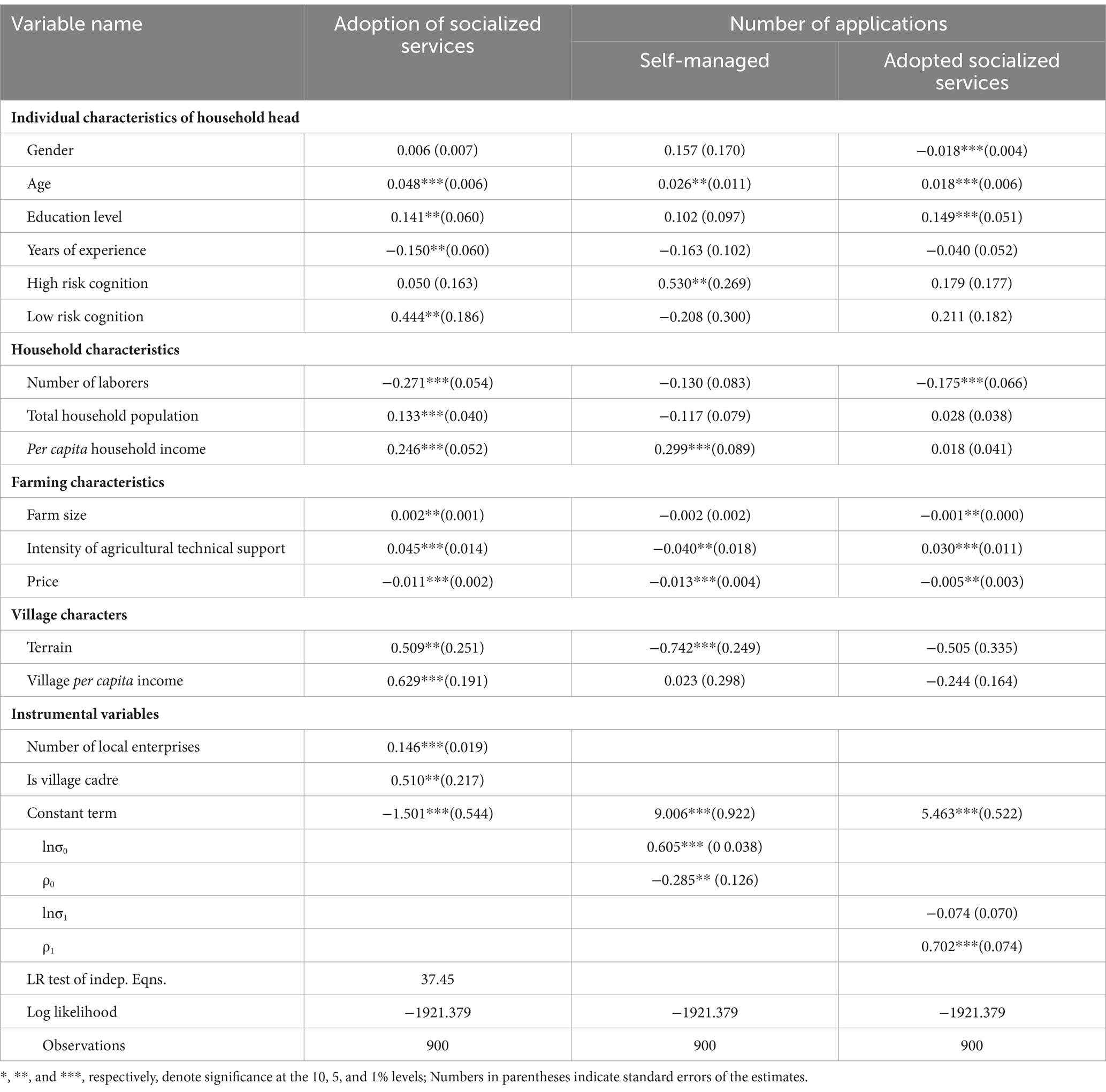
Table 2. Estimated impact of the regional pest control program service on pesticide application intensity.
Comparing the factors in Table 2, it is evident that the determinants of pesticide application intensity differ significantly between farmers who adopt the Regional Pest Control program service and those who rely on self-management. For the latter group, age, risk characteristics, per capita household income, agricultural technical support intensity, price, and village topographical features all significantly impact pesticide application intensity.
5.2 Average treatment effects of farmers’ adoption of the regional pest control program service on pesticide application intensity
Within the framework of the ESR model’s counterfactual estimation, the treatment effects of adopting the Regional Pest Control program service on the intensity of pesticide application (ATT) and the treatment effects of not adopting RPC service (ATU) can be computed using Equations 5, 6, respectively. As presented in Table 3, the actual pesticide application frequencies for self-managed and the Regional Pest Control program service-managed farms are 6.759 and 5.577 times, respectively. The Regional Pest Control program service exerts a negative treatment effect on pesticide application intensity, which is statistically significant at the 1% level. According to the ATU estimates, if self-managing farmers were to adopt the Regional Pest Control program service, their pesticide application frequency would reduce from 6.579 to 4.544 times, averaging a decrease of 2.214 applications and a reduction of 33.6%, significant at the 1% level. Conversely, ATT estimates suggest that if farmers currently using the Regional Pest Control program service were not to utilize them, their pesticide application frequency would increase from 5.577 to 7.727 times, an increase of 38.5%, also significant at the 1% level. These findings underscore that the Regional Pest Control program service, as a modern agricultural production method adapted to China’s national conditions, can effectively reduce the use of pesticides, thereby contributing to the enhancement of agricultural non-point source pollution control.
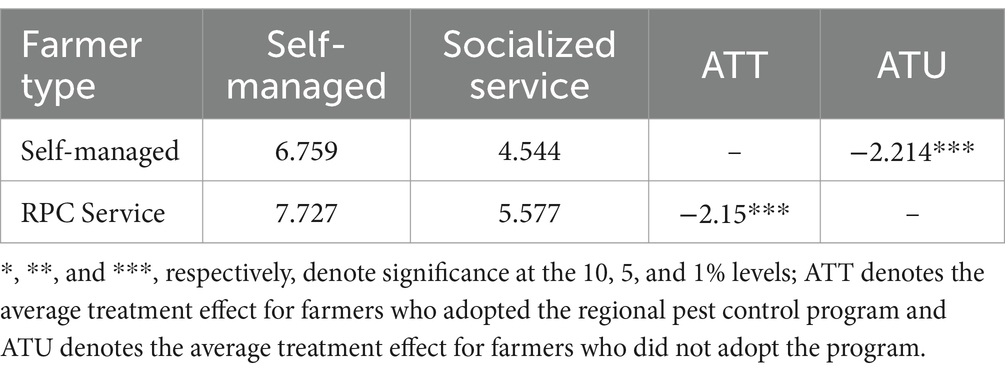
Table 3. Average treatment effects of the regional pest control program service on pesticide application intensity.
5.3 Factors influencing farmers’ adoption of the regional pest control program service and the proportion of non-hazardous pesticide usage
The analysis results from the ESR model as shown in Table 4 indicate that the LR test of independent equations rejects the null hypothesis of independence between the selection equation and the outcome equation at the 1% level. Additionally, ρ0 and ρ1 are significantly different from zero at the 5 and 1% levels, respectively. This suggests that the decision to adopt the Regional Pest Control program service and the application of non-hazardous pesticides in pest control are both influenced by unobservable factors. Consequently, the ESR model is well-suited for analyzing the impact of socialized agricultural services on agricultural non-point source pollution caused by pesticides. The model estimates presented in Table 4 demonstrate that the adoption of the Regional Pest Control program service by farmers is influenced by a multitude of factors, including individual characteristics of the farmers, family characteristics, and the features of agricultural production and management.
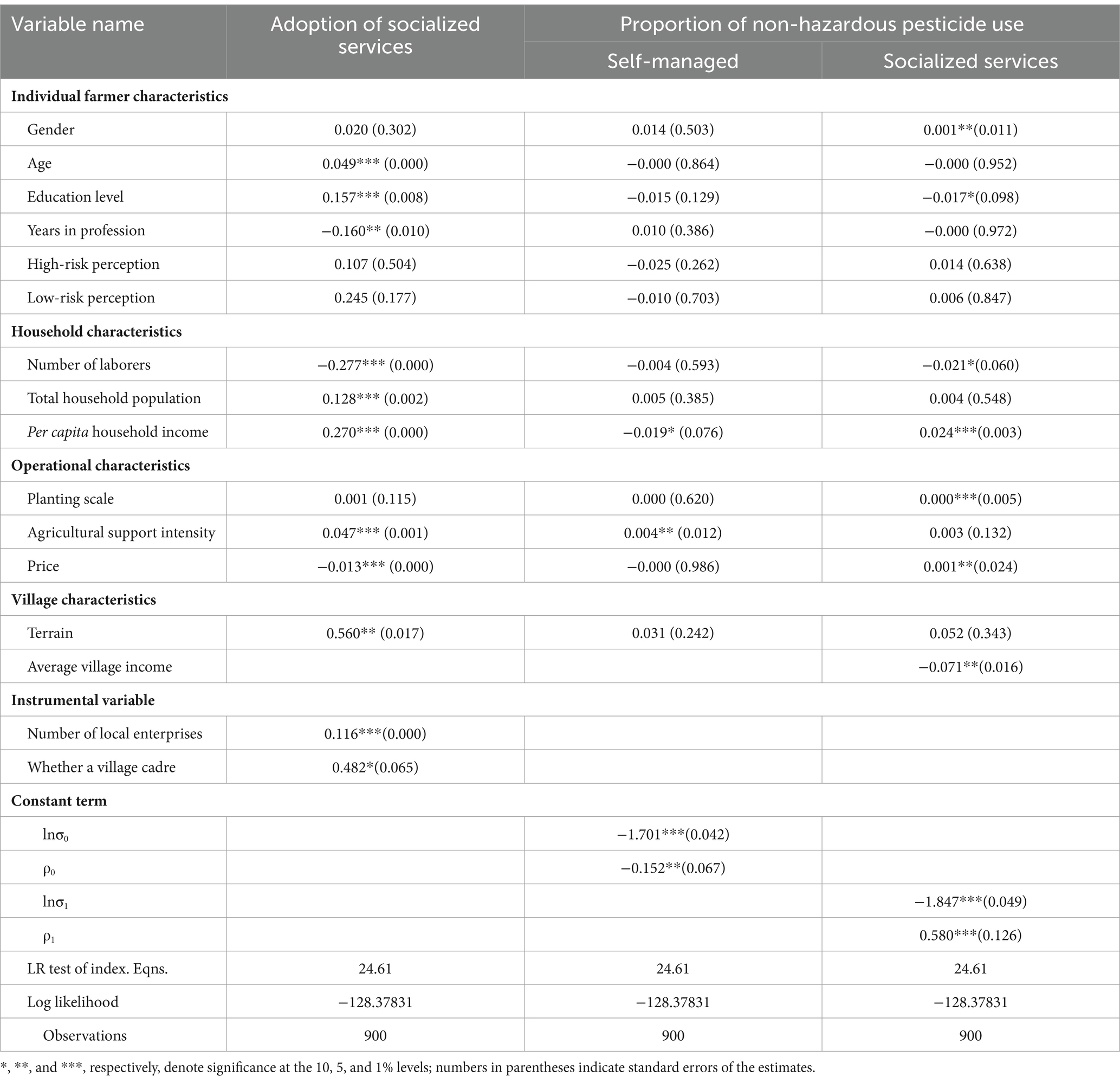
Table 4. Estimated effects of the regional pest control program service on the proportion of non-hazardous pesticide usage.
5.4 Average treatment effects of farmers’ adoption of the regional pest control program service on the usage proportion of non-hazardous pesticides
Within the ESR model framework utilizing counterfactual estimation, the Average Treatment effect on the Treated (ATT) and the Average Treatment effect on the Untreated (ATU) regarding the impact of the adoption of the Regional Pest Control program service on the proportion of non-hazardous pesticide application can be calculated using Equations 5, 6 respectively. The results, as shown in Table 5, indicate that the proportion of non-hazardous pesticide application for households practicing self-protection and those utilizing the Regional Pest Control program service are 69.2 and 70.5%, respectively. According to the ATT results, the proportion of non-hazardous pesticide application would decrease from 70.5 to 66.3%–a decline of 4.17 percentage points–if households utilizing the Regional Pest Control program service did not do so, with this effect being significant at the 5% level. The ATU value stands at 1.63%, also significant at the 5% level. Considering the variation in the proportion of non-hazardous pesticide application, particularly after excluding the impact of unobservable heterogeneity among households, the Regional Pest Control program service has increased the use of non-hazardous pesticides by 4.17 percentage points. These findings suggest that the Regional Pest Control program service is an agricultural production method well suited to the national conditions of China, as they effectively increase the utilization of non-hazardous pesticides, thereby mitigating agricultural non-point source pollution.

Table 5. Average treatment effects of the regional pest control program service on the proportion of non-hazardous pesticide usage.
5.5 Analysis of group differences in the impact of the regional pest control program service on pesticide usage
Inherent risk preferences are influenced by cognitive abilities (Dohmen et al., 2010). To elucidate the differential impacts of the Regional Pest Control program service on pesticide application across sample groups with varying risk preferences, this study categorizes farmers based on their risk aversion levels. The average treatment effects of the Regional Pest Control program service on pesticide application intensity, as measured under different risk preferences through the Endogenous Switching Regression (ESR) model, are presented in Figure 2 and Table 6.
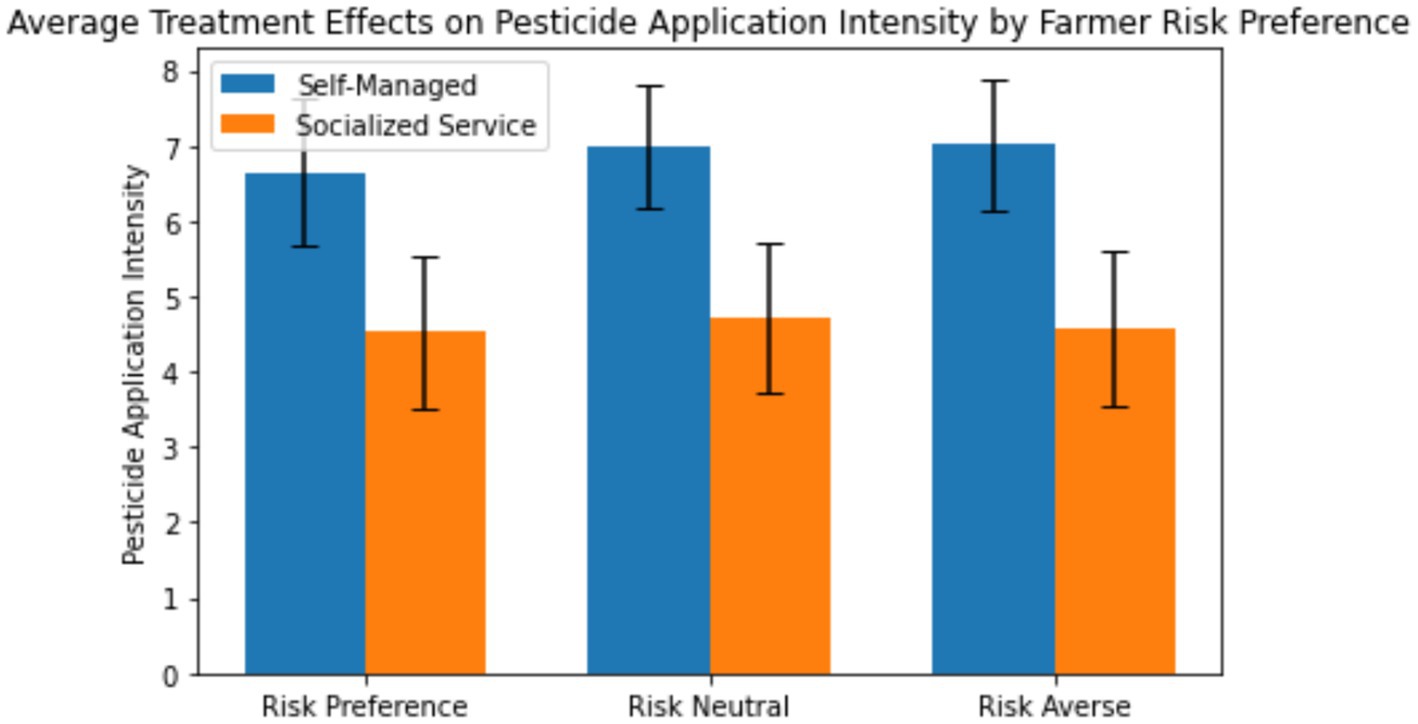
Figure 2. Average treatment effects of farmers with different risk preferences adopting the regional pest control program service on pesticide application intensity.

Table 6. Average treatment effects of farmers with different risk preferences adopting the regional pest control program service on pesticide application intensity.
Based on the outcomes presented in Table 6, it is observed that the adoption of the Regional Pest Control program service significantly reduces the intensity of pesticide application across the board, irrespective of the farmers’ risk preferences. Upon segmenting the sample according to risk preferences, it becomes apparent that for farmers adopting the Regional Pest Control program service, the higher their propensity for risk, the less pronounced is the effect of these services on reducing pesticide application intensity. In other words, farmers with a stronger aversion to risk exhibit the greatest reduction in pesticide application intensity when adopting the Regional Pest Control program service. This pattern is consistent even among farmers who have not adopted these services, indicating that risk-averse farmers would benefit most in terms of reduced pesticide application intensity from the adoption of the Regional Pest Control program service.
The average treatment effects of the Regional Pest Control program service on the proportion of non-hazardous pesticide application, as calculated by the Endogenous Switching Regression (ESR) model for different risk preferences, are indicated in Figure 3 and Table 7.
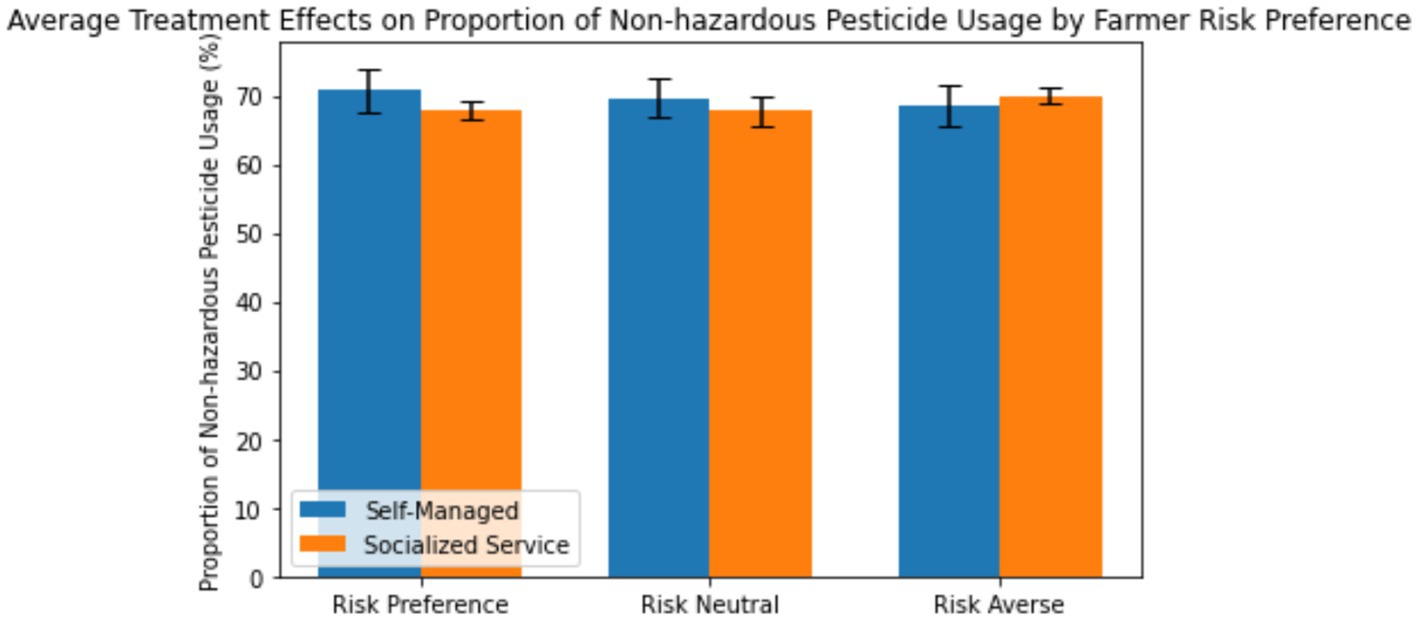
Figure 3. Average treatment effects of farmers with different risk preferences adopting the regional pest control program service on the proportion of non-hazardous pesticide usage.

Table 7. Average treatment effects of farmers with different risk preferences adopting the regional pest control program service on the proportion of non-hazardous pesticide usage.
The results presented in Table 7 reveal that, in terms of the Average Treatment Effect on the Treated (ATT), the adoption of the Regional Pest Control program service increases the proportion of non-hazardous pesticide use across all farmers, regardless of their risk preferences. However, the effect is not significantly marked. This can be attributed to the fact that farmers’ choices of pesticides are influenced not only by their own awareness and willingness but also by the supply side. Government regulations on the types of pesticides supplied mean that even if farmers adopt the Regional Pest Control program service, the proportion of non-hazardous pesticides used does not increase substantially.
Further analysis segmented by risk preference indicates that for farmers adopting the Regional Pest Control program service, those with higher risk preferences show a smaller effect of these services on increasing the use of non-hazardous pesticides. Conversely, farmers with a greater aversion to risk experience the most significant impact in terms of increasing the use of non-hazardous pesticides. The same trend is observed among farmers who have not adopted the RPC service, where the Average Treatment Effect on the Untreated (ATU) for risk-preferent and risk-neutral farmers is negative. This pattern may be due to the fact that rice farmers in China are categorized into profit-oriented and subsistence-oriented groups. Subsistence-oriented farmers, who have an intrinsic motivation for green production, are more inclined to use non-hazardous pesticides. Consequently, their adoption of the Regional Pest Control program service paradoxically results in a decrease in the proportion of non-hazardous pesticide usage (Manivong et al., 2014).
6 Conclusions and policy implications
This study, based on the survey analysis of 900 households in five provinces including Heilongjiang, Jiangsu, and Sichuan, employs an endogenous switching regression model that allows for the elimination of both observable and unobservable household heterogeneity. This approach mitigates endogeneity issues arising from sample selection and enables the estimation of average treatment effects. Using pesticide application intensity and the proportion of non-hazardous pesticide use as entry points, the study empirically examines the impact of the Regional Pest Control program service on pesticide use within a counterfactual framework. The principal findings are as follows: Firstly, farmers’ risk perception regarding the adoption of the Regional Pest Control program service significantly influences their adoption decisions. Higher levels of risk perception are associated with a decreased likelihood of adopting the RPC service. Secondly, after controlling for observable and unobservable household heterogeneity, it is evident that the Regional Pest Control program service significantly reduce pesticide application intensity and increase the proportion of non-hazardous pesticide use, thereby mitigating agricultural non-point source pollution. Thirdly, the impact of the Regional Pest Control program service on pesticide use varies significantly among different groups of farmers with varying risk preferences. Those with a higher degree of risk aversion benefit more from the adoption of the Regional Pest Control program service in terms of both reducing pesticide application intensity and increasing the use of non-hazardous pesticides.
Based on the aforementioned conclusions, the policy implications of this study are as follows: First, the significant impact of the Regional Pest Control program service on pesticide application should be fully recognized and valued. As a crucial component of modern agricultural practices, the Regional Pest Control program service not only ensures the quantitative safety of agricultural products but also effectively reduces the intensity of pesticide use, thereby enhancing China’s agricultural competitiveness. This bears substantial social significance and industrial value. Second, there should be an intensification of efforts to promote the Regional Pest Control program service, improve pest and epidemic monitoring and reporting, and ensure stable crop yields. The introduction of agricultural insurance tailored to these services could alleviate farmers’ concerns over potential yield losses post-adoption and reduce their risk perception associated with these services. Third, it is essential to increase fiscal support for the Regional Pest Control program service to raise continually the willingness of both risk-averse and profit-oriented farmers to adopt such services.
Data availability statement
The raw data supporting the conclusions of this article will be made available by the authors, without undue reservation.
Author contributions
BX: Funding acquisition, Writing – original draft, Conceptualization, Formal analysis. FK: Supervision, Writing – review & editing.
Funding
The author(s) declare that financial support was received for the research, authorship, and/or publication of this article. This paper was supported by the Shandong Province Social Science Planning Research Project (Grant No. 21CXSX10).
Conflict of interest
The authors declare that the research was conducted in the absence of any commercial or financial relationships that could be construed as a potential conflict of interest.
Publisher’s note
All claims expressed in this article are solely those of the authors and do not necessarily represent those of their affiliated organizations, or those of the publisher, the editors and the reviewers. Any product that may be evaluated in this article, or claim that may be made by its manufacturer, is not guaranteed or endorsed by the publisher.
References
Abdul Salam, Y., and Phimister, E. (2017). Efficiency effects of access to information on small-scale agriculture: empirical evidence from Uganda using stochastic frontier and IRT models. J. Agric. Econ. 68, 494–517. doi: 10.1111/1477-9552.12194
Belay, A., Recha, J. W., Woldeamanuel, T., and Morton, J. F. (2017). Smallholder farmers’ adaptation to climate change and determinants of their adaptation decisions in the central Rift Valley of Ethiopia. Agric. Food Secur. 6, 1–13. doi: 10.1186/s40066-017-0100-1
Carney, D. (1995). The changing public role in services to agriculture: a framework for analysis. Food Policy 20, 521–528. doi: 10.1016/0306-9192(95)00044-5
Chaoan, W. (2011). Specialized unified prevention and control: an important choice for modern agricultural development. China Plant Prot. Guide 31, 5–8. doi: 10.3969/j.issn.1672-6820.2011.09.001
Dohmen, T., Falk, A., Huffman, D., and Sunde, U. (2010). Are risk aversion and impatience related to cognitive ability? Am. Econ. Rev. 100, 1238–1260. doi: 10.1257/aer.100.3.1238
Fabregas, R., Kremer, M., and Schilbach, F. (2019). Realizing the potential of digital development: the case of agricultural advice. Science 366:eaay3038. doi: 10.1126/science.aay3038
Fan, J., and Yunyun, Y. (2023). A comprehensive review of research on agricultural socialized services in China. Western Forum 33, 111–124. doi: 10.3969/j.issn.1674-81312023.02.008
Fuchu, Y. (2017). Practices and reflections on the construction of modern plant protection system in Hunan Province. China Plant Prot. Guide 37, 75–79. doi: 10.3969/j.issn.1672-6820.2017.11.018
Gbashi, S., Adebo, O. A., Adebiyi, J. A., Targuma, S., Tebele, S., Areo, O. M., et al. (2021). Food safety, food security and genetically modified organisms in Africa: a current perspective. Biotechnol. Genet. Eng. Rev. 37, 30–63. doi: 10.1080/02648725.2021.1940735
Heckman, J., Tobias, J. L., and Vytlacil, E. (2001). Four parameters of interest in the evaluation of social programs. South. Econ. J. 68, 210–223. doi: 10.1002/j.2325-8012.2001.tb00416.x
Hou, L., Liu, P., Huang, J., and Deng, X. (2020). The influence of risk preferences, knowledge, land consolidation, and landscape diversification on pesticide use. Agric. Econ. 51, 759–776. doi: 10.1111/agec.12590
Huang, J., Hu, R., Rozelle, S., and Pray, C. (2008). Genetically modified rice, yields, and pesticides: assessing farm-level productivity effects in China. Econ. Dev. Cult. Change 56, 241–263. doi: 10.1086/522898
Kang, X., Jinghua, X., Nankun, Y., and Yaping, L. (2015). Social deterrence signals and value reconstruction: an institutional analysis of social co-governance in food safety. Econ. Perspect. 1, 4–16.
Ke, W. (2017). China’s per mu chemical fertilizer usage is 2.6 times that of the U.S., pesticide utilization rate only 35%: Agricultural inputs market awaits the 'Era of large-scale farming.
Labarthe, P., and Laurent, C. (2013). Privatization of agricultural extension services in the EU: towards a lack of adequate knowledge for small-scale farms? Food Policy 38, 240–252. doi: 10.1016/j.foodpol.2012.10.005
Lokshin, M., and Sajaia, Z. (2004). Maximum likelihood estimation of endogenous switching regression models. Stata J. 4, 282–289. doi: 10.1177/1536867X0400400306
Ma, W., and Abdulai, A. (2016). Does cooperative membership improve household welfare? Evidence from apple farmers in China. Food Policy 58, 94–102. doi: 10.1016/j.foodpol.2015.12.002
Manivong, V., Newby, J., and Cramb, R. (2014). Subsistence-oriented rice farming in the rainfed lowlands of central and southern Laos–a policy dilemma. A Policy Dialogue On Rice Futures: Rice-Based Farming Systems Research in the Mekong Region, No. 142, pp. 128–135. Available at: http://espace.library.uq.edu.au/view/UQ:350558
Narayanan, M., Devarayan, K., Verma, M., Selvaraj, M., Ghramh, H. A., and Kandasamy, S. (2024). Assessing the ecological impact of pesticides/herbicides on algal communities: a comprehensive review. Aquat. Toxicol. 268:106851. doi: 10.1016/j.aquatox.2024.106851
Ngo-Hoang, D. (2024). Sustainable agriculture: Aquaponics-integrated greenhouse cultivation of cantaloupe with drip irrigation system.
Ning, A., Shan, Z., and Zhigang, X. (2024). Research on pesticide application intensity and outsourcing services in the 'Principal-Agent' perspective. Agricultural Technology Economy.
Pedersen, A. B., Nielsen, H. Ø., Christensen, T., Ørum, J. E., and Martinsen, L. (2019). Are independent agricultural advisors more oriented towards recommending reduced pesticide use than supplier-affiliated advisors? J. Environ. Manag. 242, 507–514. doi: 10.1016/j.jenvman.2019.04.091
Peng, Z., Xiaohong, L., and Yu, W. (2024). The impact of Farmers' digital literacy on the reduction of chemical pesticide use and its mechanisms. China Soft Sci. 2024, 64–73. doi: 10.3969/j.issn.1002-9753.2024.02.007
Ren, Y., Zhao, J., Liu, Y., Li, M., Tang, J., Ji, X., et al. (2023). Effects of diseases and pests on quality, industry and international trade of tea. Plant Dis. and Pests 14, 30–32. doi: 10.19579/j.cnki.plant-d.p.2023.03.010
Ruiyao, Y., and Bin, X. (2014). Analysis of the demonstration effect of Farmers' adoption of agricultural socialized services: the case of unified Pest and disease prevention and control. China Rural Econ. 2014, 30–41. doi: 10.12062/cpre.20170322
Ruiyao, Y., and Bin, X. (2017). The impact of specialized prevention and control Services for Crop Pests and Diseases on the intensity of pesticide application. China Popul. Resour. Environ. 27, 90–97.
Skinner, D. J., Rocks, S. A., and Pollard, S. J. (2016). Where do uncertainties reside within environmental risk assessments? Expert opinion on uncertainty distributions for pesticide risks to surface water organisms. Sci. Total Environ. 572, 23–33. doi: 10.1016/j.scitotenv.2016.07.164
Win, T. T., Thu, M., Swe, T. M., Ko, T., Aung, T. T., Ei, H. H., et al. (2020). Degradation of soil quality in Mandalay region of Myanmar due to overuse of pesticides in agriculture. Asia Pac. J. Rural Dev. 30, 113–138. doi: 10.1177/1018529120977247
Wuepper, D., Roleff, N., and Finger, R. (2021). Does it matter who advises farmers? Pest management choices with public and private extension. Food Policy 99:101995. doi: 10.1016/j.foodpol.2020.101995
Xingdong, M., and Xuexi, H. (2019). Standardized apple production, regulatory effects, and recommendations for improvement: based on a survey analysis of 960 apple growers in 11 counties across Shandong, Shaanxi, and Gansu provinces. Issues Agric. Econ. 2019, 37–48.
Xu, H., Chaiboonsri, C., and Chokethaworn, K. (2023). Research on export prediction model based on machine learning: Application of China's agricultural products export. Proceedings of; 1-1-2023 2023.
Zhang, H., Li, J., and Quan, T. (2023). Strengthening or weakening: the impact of an aging rural workforce on agricultural economic resilience in China. Agriculture 13:1436. doi: 10.3390/agriculture13071436
Keywords: regional pest control program, endogenous switching regression, perceived risks, pesticide application practices, agricultural non-point source pollution
Citation: Xu B and Kong F (2024) Impact of regional pest control on pesticide application in China from a perceived risks perspective. Front. Sustain. Food Syst. 8:1407961. doi: 10.3389/fsufs.2024.1407961
Edited by:
Noshaba Aziz, Shandong University of Technology, ChinaReviewed by:
Berhan Teklu, Ministry of Agriculture, EthiopiaDiana Obregon, Cornell University, United States
Copyright © 2024 Xu and Kong. This is an open-access article distributed under the terms of the Creative Commons Attribution License (CC BY). The use, distribution or reproduction in other forums is permitted, provided the original author(s) and the copyright owner(s) are credited and that the original publication in this journal is cited, in accordance with accepted academic practice. No use, distribution or reproduction is permitted which does not comply with these terms.
*Correspondence: Fanzhu Kong, dG9uZ2ppaHJkQDE2My5jb20=
 Bin Xu
Bin Xu Fanzhu Kong
Fanzhu Kong